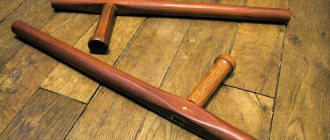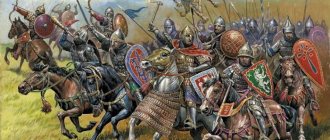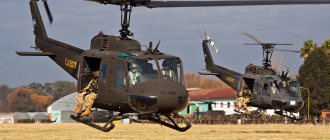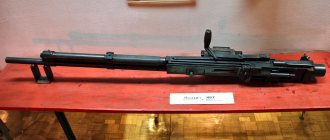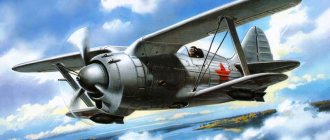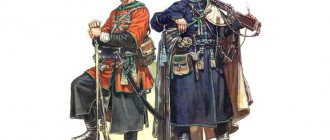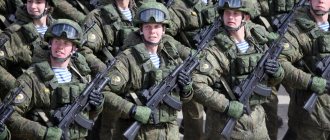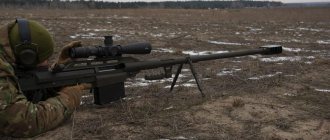Equipment of ancient warriors: legionnaire of the era of Trajan
Plate armor
The reliefs of Trajan's Column, erected in Rome in 113 to commemorate the conquest of Dacia, depict legionnaires dressed in plate armor, the so-called. lorica segmentata, while auxiliary infantry and cavalry wear chain mail or scale armor. But such a division is probably not true. Contemporary to the Column reliefs, depictions of Trajan's Trophy at Adamiklissia show legionnaires wearing chain mail, and archaeological finds of pieces of plate armor in border forts occupied by auxiliary units indicate that soldiers in these units wore lorica.
The name lorica segmentata is a modern term for plate armor, known from numerous images of the 1st–3rd centuries. Its Roman name, if there was one, remains unknown. The oldest finds of plates of this armor come from excavations at Mount Kalkriese in Germany, identified as the site of the battle in the Teutoburg Forest. Its appearance and spread therefore date back to the final stage of the reign of Augustus, if not to an earlier time. Various points of view have been expressed regarding the origin of this type of armor. Some derive it from the solid armor worn by the Gallic gladiators, the Crupellars, while others see it as an eastern development, better suited to holding the arrows of Parthian archers in comparison with traditional chain mail. It is also unclear the extent to which plate armor was widespread in the ranks of the Roman army: whether soldiers wore it everywhere or only in some special units. The extent of the distribution of finds of individual pieces of armor rather testifies in favor of the first hypothesis, however, there can be no talk of uniformity of protective weapons in the style of images of reliefs of Trajan’s Column.
In the absence of real finds about the structure of plate armor, many different hypotheses were put forward. Finally, in 1964, during excavations at a border fort in Corbridge (Britain), two well-preserved examples of armor were found. This allowed the British archaeologist H. Russell Robinson to reconstruct the Lorica segmentata of the late 1st century, as well as draw certain conclusions about the structure of the armor of a later period, previously found during excavations at Newstead. Both armor belonged to the so-called laminar type of armor. Horizontal stripes, slightly funnel-shaped, were riveted from the inside onto a leather belt. The plates overlapped slightly on top of one another and formed an extremely flexible metal covering for the body. Two semicircular sections made up the right and left parts of the armor. With the help of straps they were fastened on the back and chest. A separate composite section was used to cover the upper chest. Using straps or hooks, the bib was connected to the corresponding side half. Flexible shoulder pads were attached to the breastplate on top. To put on the armor, it was necessary to put your hands through the side openings and fasten it on the chest, like a vest.
Lamellar armor was durable, flexible, lightweight and at the same time a very reliable means of protection. In this capacity, he existed in the Roman army from the beginning of the 1st to the middle of the 3rd century AD.
Roman warrior weapons
Dart, spear, sword, armor, shield... All this, as well as courage and unquestioning submission to the commander, made the Roman warrior practically invulnerable in battle.
During the campaign, the soldier had to carry weapons, armor and carry-on luggage, which consisted of food supplies, dishes, a shovel and an ax.
Clothes and shoes
The clothing of Roman soldiers consisted of a rough woolen shirt (tunic) length to mid-thigh, chain mail or armor made of flexible metal plates, a leather belt with attached belts covered with iron, and a woolen cloak, which was removed before battle. To protect against the cold, necks were covered with scarves, and legs were “wound with knitted or woven woolen bandages. In the northern provinces, soldiers wore short trousers, just below the knee, under their tunic. The footwear for ordinary soldiers and centurions were low boots, laced with straps (kaliga), which left the toes free. Thanks to the nails driven into the soles, the caligas could withstand heavy weight and long distances.
Weapons and armor
Each legionnaire was armed with a long spear called a pilum. It consisted of 2 parts: a shaft, one end of which was pointed for sticking into the ground, and a sharp iron tip. The impact force of such a spear was very great: it easily pierced both the shield and the shell. In hand-to-hand combat, legionnaires used a short sword with a wide, double-edged blade, and a dagger. A large rectangular curved shield served for protection. It was made of thin boards, which were covered with cowhide, and the edges were lined with copper or iron.
On the outside in the center of the shield there was a small metal bulge to deflect enemy arrows and spears. The head, face and neck of the legionnaires were covered with a metal helmet. Some soldiers wore metal knee pads on their legs.
Centurions' helmets were decorated with feather or horsehair crests so that soldiers could clearly see their commanders on the battlefield. The most experienced and courageous warriors were usually appointed as centurions, so their armor was often hung with awards - gold and silver mugs with images of the heads of commanders or deities. The insignia of centurions and at the same time a weapon for punishing disobedient soldiers was a grape rod called vitis.
Horsemen
Compared to legionnaires, an additional detail in the clothing of Roman horsemen were leather legguards and leggings. During battle, horsemen used light round shields, long spears and swords so that they could fight while remaining in the saddle. The heads and backs of horses were usually covered with leather or metal blankets and chain mail. Roman horsemen used spurs to control their horses; saddles, stirrups and horseshoes were not yet common at that time.
Standard Bearer
The banner of the maniple consisted of a spear, pointed at the bottom for sticking into the ground, and a crossbar attached to it, on which there was a plate with the number of the maniple, its symbol and insignia awarded to the detachment for military merit. The soldier responsible for guarding the banner of the maniple was called a signifer.
Share link
Legionnaires' equipment
Legionnaire equipment for the period 1-2 centuries AD. could consist of the following elements:
Fabric/leather products:
- Balaclava
- Penula, Sagum
- Focale
- Subarmalis
- Tunic
- Marriages
- Subligakulum
- Caligi, Calzei
- Socks
- Windings
Metal protective equipment:
- Galea
- Segmentata, Squamata, Hamata
- Cingulum
- Manika
- Ocrea
Weapon:
- Pilum
- Gladius
- Pugio
- Scutum
Additional items:
- Fibula
- Rings
- Saccus
- Wallet
Not all of the above items of equipment were used necessarily and everywhere. For example, according to the images that have come down to us, the legionnaires could have been without armor at all. Manica and, in particular, greaves were not widespread (the latter were characteristic of the later weapons of legionnaires of the early 2nd century). The same applies to simpler pieces of equipment, such as braids and subarmalis.
Reconstruction
You should carefully choose your time period, since equipment changed quite significantly from the period of the Republic to the late Empire. If we consider the most typical periods for ancient reconstruction in Russia (which our club adheres to), then there are two most common images: a legionnaire of the second half of the 1st century AD. and the first half of the 2nd century AD. Their main differences are in the helmet, lorica (if a segmentata is used - corbridge for a legionnaire of the early period, newstead - for a late one) and jockstraps on the cingulum (in the uniform of a legionnaire of the 2nd century they are much shorter , or even completely absent). The greave on the left leg is an attribute of a legionnaire of a later period.
There are also less obvious differences in weaponry: the pugio must be type 2 for a 1st century AD legionary, and type 3 for a 2nd century AD legionnaire, while the Fulchem type gladius can only be used by a 1st century AD legionary.
You should start creating an image with the simplest things included in the minimum set: tunic, shoes (caligas/calcei), cingulum.
Legionnaire mid-1st century, reconstruction
Late 1st century legionnaire, reconstruction
Legionnaire in civilian clothes
Composition and organization
The core of the army was still the legion. It numbered up to 5 thousand people and was headed by the imperial legate with the rank of propraetor. Each legion was given a contingent of auxiliaries, usually equal in number to itself, led by a Roman prefect. It was dominated by shock cavalry formations (alas) and individual detachments of up to a thousand people (vexillations).
Together with auxiliary detachments, the legion numbered up to 10 thousand people and turned into a tactical formation of various types of troops capable of carrying out an independent combat operation (like a modern division).
Each legion received a number and an honorary nickname - XX “Victorious”, VI “Iron”, XII “Lightning”, XIV “Twin”, V “Larks” (for the plume in the form of a characteristic crest on their helmets). The total number of troops under Augustus reached 250 thousand.
The bulk of the legions were stationed on the Rhine (8 legions) and on the Danube (15 legions), two (then one) legions were stationed in the north of Spain, and 4 legions were stationed in Syria.
The imperial legions under Augustus were reduced to 25 units by the end of his reign; during the civil wars there were many more than the canonical number of 28.
The legion began to be led by the legate (legatus), and not by the tribunes, who had previously ruled the legion for two months in alternation, which, of course, did not lead to good results. The legate was, as a rule, a senator who held this position for 3 years; six military tribunes were directly subordinate to him - five staff officers and the sixth - a candidate for senator.
From bottom to top, the legion consisted of hastati, principles and triarii, these were the rank and file. Among the legionnaires there were evocates who had served their term and retired, but returned to service voluntarily at the invitation of the consul or another commander.
The dean (decanus) was the commander of 6-10 soldiers with whom he lived in the same tent. Decurion (decurio), commanded a cavalry detachment of 10 to 30 horsemen as part of the legion.
Centurion (centurio), commander of a century, there were 59 of them in each legion. Typically, this post was given to veteran legionnaires, however, one could become a centurion by direct decree of the emperor or other high-ranking official.
Primipilus (primus pilus) - the highest-ranking centurion of the legion, who led the first double century. In the 1st-2nd centuries AD. e., upon dismissal from military service, the primipil was enrolled in the class of horsemen and could achieve a high position in the civil service.
Senior command staff
Tribune of Angustiklavii.
Each legion had five military tribunes from the equestrian class, most often they were professional soldiers, but sometimes they had no military experience; they occupied high administrative posts in the legion, and during hostilities they could, if necessary, command the legion. They were given tunics with narrow purple stripes (angusticlava), hence the name of the position. The command post of military tribune was established by the laws of Canuleus in 444 BC. e., but, more often, the tribunes entrusted the control of the legion to the legates. The camp prefect (praefectus castrorum) is the third most senior post in the legion. Usually, it was occupied by a promoted veteran soldier who had previously held the post of one of the centurions.
Tribune Laticlavius (tribunus laticlavius) from the word "laticlava", which means two wide purple stripes on the tunic worn by officials of senatorial rank. He was appointed by the emperor or the senate, a kind of commissar of the legion, inexperienced, but responsible for carrying out the line needed by the senate.
Legate of a legion (legatus legionis) is the direct commander of the legion. The emperor usually appointed the former tribune for three or four years, but the legate could hold this post for much longer. In the provinces where the legion was stationed, the legate was also the governor. Where there were several legions, each of them had its own legate, and they were all under the general command of the governor of the province.
Legate Augusti propraetor (legatus Augusti pro praetore) - commander of a formation of two or more legions. The imperial legate also served as governor of the province in which the legions he commanded were stationed. Coming from the senatorial class, the Imperial Legate was appointed by the emperor himself and usually held the position for three or four years.
Legionnaires enlisted in the army at the age of 17 to 20 and served for 20 years, in the auxiliary troops - 25. The transition to permanent mercenary service was completed, i.e. professional army. Recruitment into the troops was carried out voluntarily, but often their recruitment was forced, especially to replenish auxiliary forces. The legionnaire received 225 denarii per year, auxiliaries from the local population of the provinces received half as much, but with the prospect of becoming Roman citizens upon retirement.
Augustus introduced the strictest discipline in the army. The recruit took an oath of allegiance to the emperor; he had to live in a military camp and engage in military exercises. A non-combatant soldier had to be employed in construction work to build camps, fortifications, and lay roads, from which he was exempt for excellent service and military merit (beneficiaries).
Augustus also introduced the legal concept of "camp peculium", according to which everything a soldier acquired through his service belonged to him personally, and not to his father. At the age of about 40, military personnel retired, received the title of veteran, a plot of land of several jugeras, and became landowners. Only then could the legionnaire start a legal family.
Augustus addressed the legionnaires not as “comrades-in-arms,” according to the old tradition, but as “soldiers”—an obedient instrument for strengthening the new regime. But the new position of the army also contained dangerous pitfalls - the emperor could appoint troops not only in Rome, but also in the provinces.
The legionnaires were not heroes and also suffered defeats, but they were hard workers on whose shoulders the Roman Empire stood for a thousand years.
